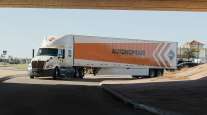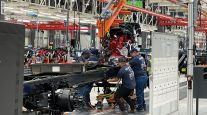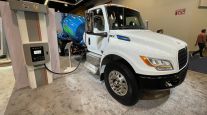Navistar Begins Shipping Trucks with 2010-Compliant Engines
This story appears in the Sept. 13 print edition of Transport Topics.
Truck and engine maker Navistar Inc. has begun shipping 2010-compliant heavy-duty engines, including more than 225 tractors with its 13-liter MaxxForce engines, the company said.
Navistar said the first trucks with 2010 engines moved last month, sent either straight to customers or to dealers for on-the-lot inventory.
In addition to the Class 8 vehicles, Navistar has shipped 3,000 school buses and Class 6 and 7 medium-duty trucks powered by engines that meet the Environmental Protection Agency’s 2010 emissions standards. It planned to ship 400 Class 6-8 vehicles during the week of Sept. 6.
Daniel Ustian, Navistar’s chairman and chief executive officer, announced the shipments during the corporation’s Sept. 8 earnings conference call. “While doing all of that, we know we had to make some money and we did that,” he said.
Ustian said the core North American truck business has improved from a year ago, but he also said a sales surge in military vehicles and more medium-duty engine sales in South America were helpful in the quarter just ended.
Navistar reported net income of $149 million, or $1.83 a share, for the three months ended July 31. During the same time last year, the company lost $5 million, or 16 cents a share. Quarterly revenue rose 28.5%, year-over-year, to $3.22 billion from $2.51 billion, with sales of military vehicles providing much of the growth.
Navistar reports in three manufacturing segments, and the improving truck group was entirely responsible for the company’s financial turnaround. The truck group had a quarterly operating profit of $227 million, compared with a $28 million loss a year ago.
The parts division earned $52 million, down from $93 million in the 2009 quarter, while the engine division lost $1 million after earning $45 million a year ago.
Ustian said that new truck orders probably have been hindered by worries about the U.S. economy’s health, although Navistar’s own business plan anticipates a slow but steady recovery that should accelerate next year.
He said Navistar’s production costs had been helped by significant logistics savings, and he credited Menlo Worldwide Logistics, a division of Con-way Inc.
Ustian also said that there is an industrywide shortage of diesel particulate filters because of a supplier’s inability to ramp up production.
While EPA’s latest standards on nitrogen oxide emissions cover diesel engines made on or after Jan. 1, most of the trucks sold this year actually have used 2009 engines that were kept in inventory (click here for previous story).
Of the four major corporations that build heavy-duty trucks in the United States and Canada, Navistar was the last to begin selling the 2010-compliant models, its first units in August. The other three are Daimler AG, Paccar Inc. and Volvo AB.
Ustian said Navistar’s sales strategy is built around 13-liter engines.
“Only about 20% of the market really needs a 15-liter engine,” he said, offering Canada as a major exception to the U.S. trend. Navistar has been marketing its 13-liter model as a low-weight, fuel-efficient alternative to 15-liter power plants.
Despite the OEM’s emphasis on the smaller models, Ustian also said he will get 20 to 35 MaxxForce
15-liter engines to customers during October to December; that he expects EPA to certify the 15-liter model in December; and that Navistar will start selling trucks with 2010-compliant 15-liter engines in “small volumes” in January.
“The strength in Navistar’s fiscal third-quarter earnings was largely led by the 800 to 1,000 MRAP shipments during the quarter,” said stock analyst Tim Denoyer of Wolfe, Trahan & Co., referring to the company’s mine-resistant, ambush-protected military vehicles.
“The surprisingly weak truck shipments may be a result of Navistar’s batch production, where it has been building and holding trucks for quality assurance,” Denoyer wrote to his firm’s clients on Sept. 8.
For Navistar’s nine-month results, it earned $222 million, or $2.51 a share, compared with $241 million, or $3.27 a share, for the year-ago period. Revenue grew 5.9%, year-over-year, to $8.77 billion from $8.28 billion.




